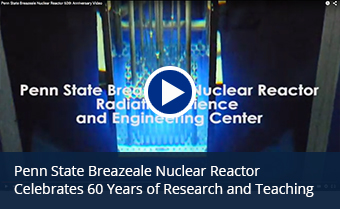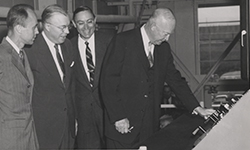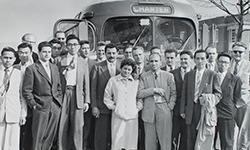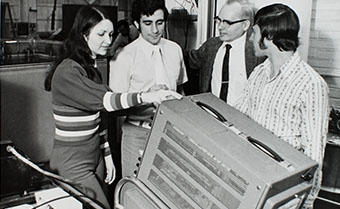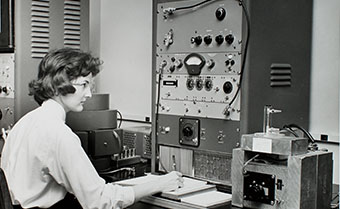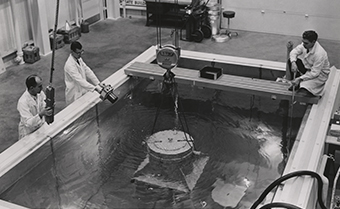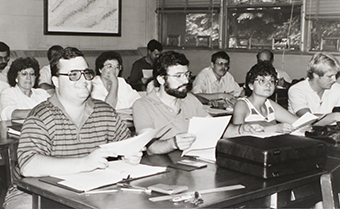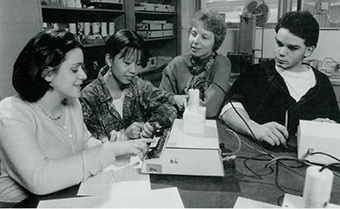
Nuclear Engineering History at Penn State
A Nuclear Reactor at Penn State
Nuclear engineering education and research at Penn State began in 1953 when University President Milton Eisenhower provided Engineering Dean Eric A. Walker $250,000 in equity from a decommissioned coffee shop in the basement of Old Main to build a nuclear research reactor for University-wide faculty and student research. William M. Breazeale was hired to initiate the construction of the reactor facility, which started operation on August 15, 1955. The Breazeale Nuclear Reactor facility remains in operation as the first and longest operating licensed nuclear reactor in the United States.
Breazeale began offering nuclear engineering courses in the fall of 1953 and was appointed as the first professor of nuclear engineering at Penn State in July 1954. By 1960, there were 27 faculty members and 33 graduate students from five University colleges utilizing the reactor. In April 1956, nuclear engineering education at Penn State got a boost when, in response to President Dwight D. Eisenhower's 1953 Atoms for Peace speech, the U.S. government established the International School of Nuclear Science and Engineering (ISNSE) at Penn State and North Carolina State Universities. The ISNSE was established to educate scientists and engineers from foreign countries in the newly declassified nuclear science and engineering information. During the six sessions conducted at Penn State between April 1956 and January 1959, a total of 175 scientists and engineers from 39 countries participated; many went on to lead nuclear programs in their home countries.
Building a Department
In 1959, the University established a formal nuclear engineering department and master's degree program. Nunzio J. Palladino was hired as professor and department head. When the Department of Nuclear Engineering opened its doors in fall 1959, it consisted of three faculty members and eight master’s students. In 1961, five of those students received the first Penn State nuclear engineering degrees. The nuclear engineering program recognized the need to expand as the first group of students completed their degrees, so in 1963, the department established a doctoral degree program. Soon after, in 1968, the department established an undergraduate program in response to the demand for nuclear engineers to design, construct, and operate nuclear power reactors for electricity generation.
The Merger
With the announcement of Penn State’s West Campus expansion, the Department of Nuclear Engineering was scheduled to be moved to the new Leonhard Building. However, in January 1997, Engineering Dean David N. Wormley announced plans to merge the Departments of Mechanical Engineering and Nuclear Engineering. The goal of the administrative consolidation was to allow for the continued existence of the nuclear engineering program in light of declining enrollments. The new department was named the Department of Mechanical and Nuclear Engineering.
The nuclear engineering program faculty and staff were relocated to Reber Building in order to occupy the same space as the mechanical engineering faculty and staff. After the merger, nuclear engineering enrollments increased from 31 students 1999 to 92 students in 2004. The availability of a concurrent degree was a strong contributor to the increased enrollment.
The Separation
In 2018, the Penn State College of Engineering announced nuclear engineering would become an independent department and named the Ken and Mary Alice Lindquist Department of Nuclear Engineering.
In addition to broadening research efforts, a standalone nuclear engineering department will allow for expanded academic offerings and specialized concentrations.
Led by Justin Schwartz, the current Harold and Inge Marcus Dean of Engineering, the separation will build on the program’s strengths and position the University as a leader in clean energy production.
“As climate change has become one of the principal societal issues facing the world, nuclear power remains the major non-fossil fuel source that can deliver significant amounts of carbon-free electricity,” Schwartz said. “This increased effort at Penn State is not only strategically wise, but critical to the world’s energy needs.”
Widespread nuclear proliferation has also underscored the need for leadership in nuclear security. “The threat of nuclear terrorism is simply not going to go away,” Schwartz said. “Expanding the department will amplify our efforts and help ensure the United States is prepared to face these issues.”
As mechanical and nuclear engineering diverge, Penn State has the historical success and strength to not only remain a leader in both disciplines, but to expand and thrive well in the future.
